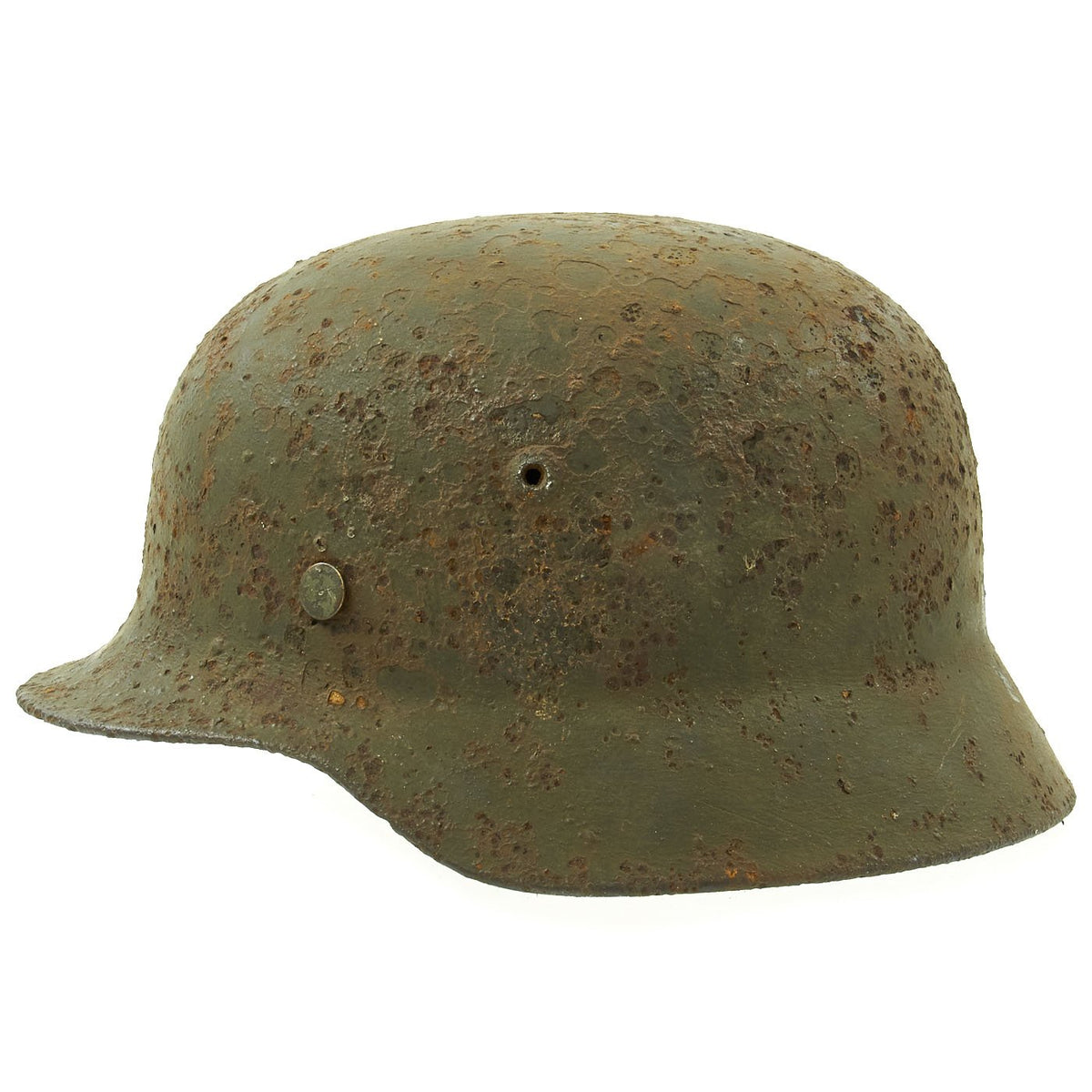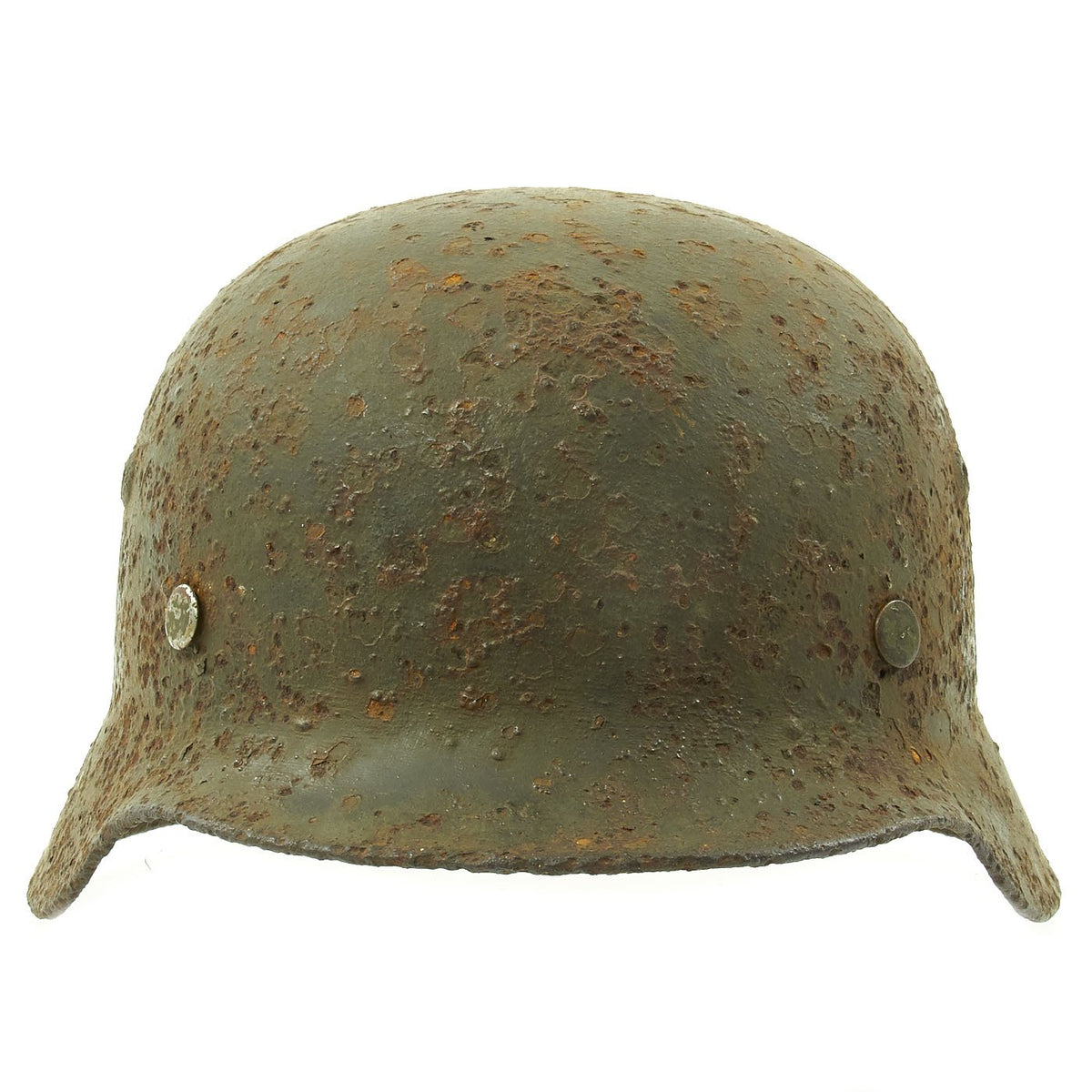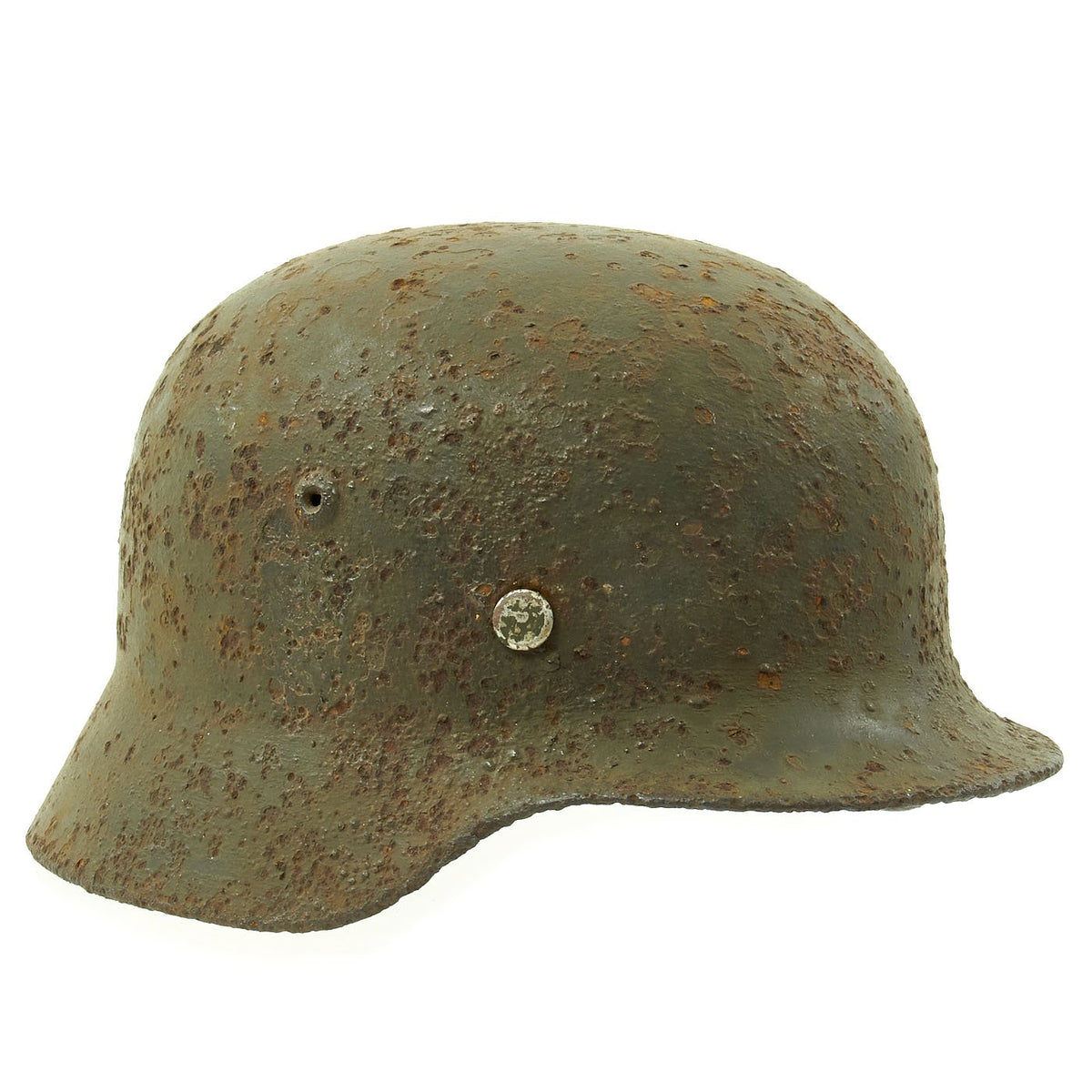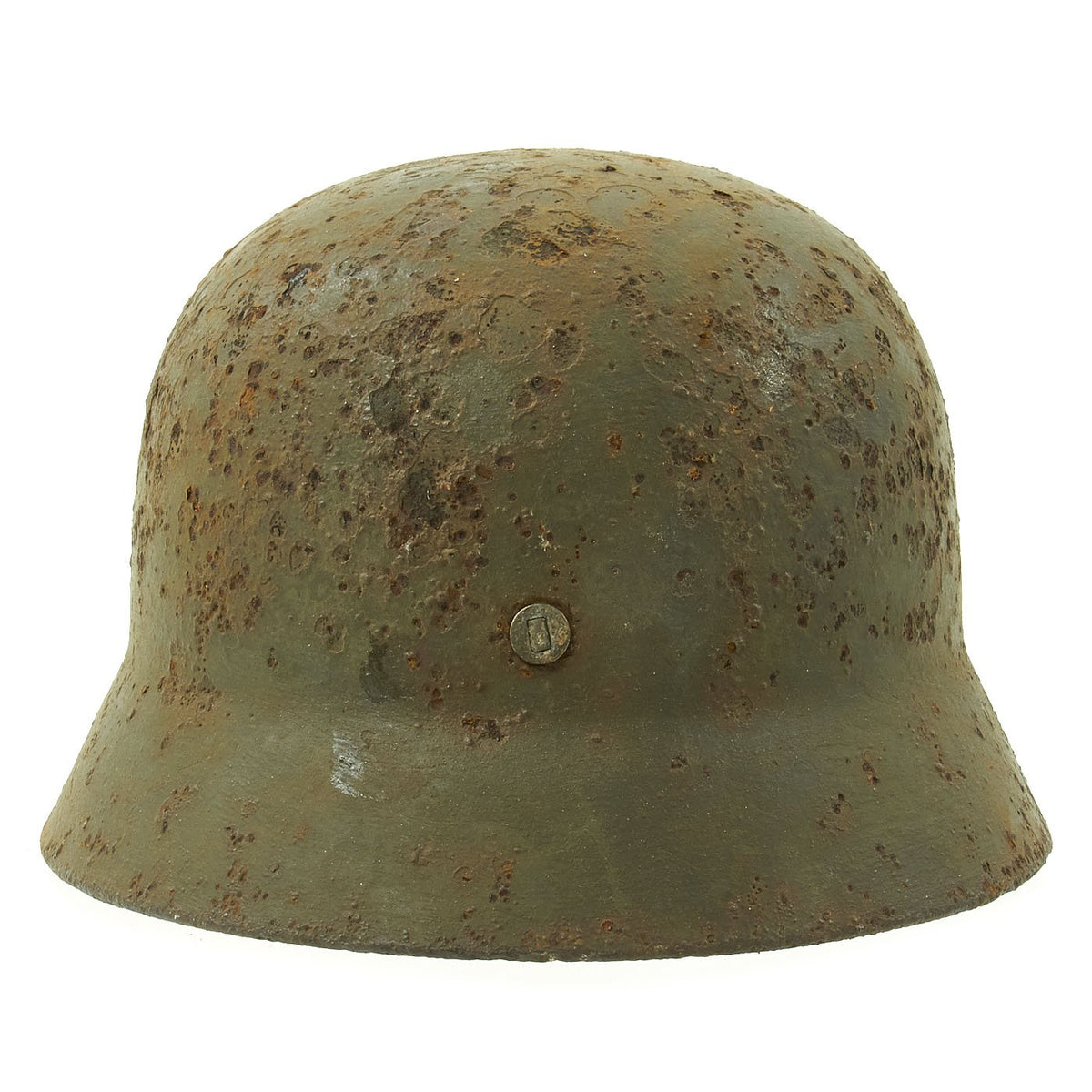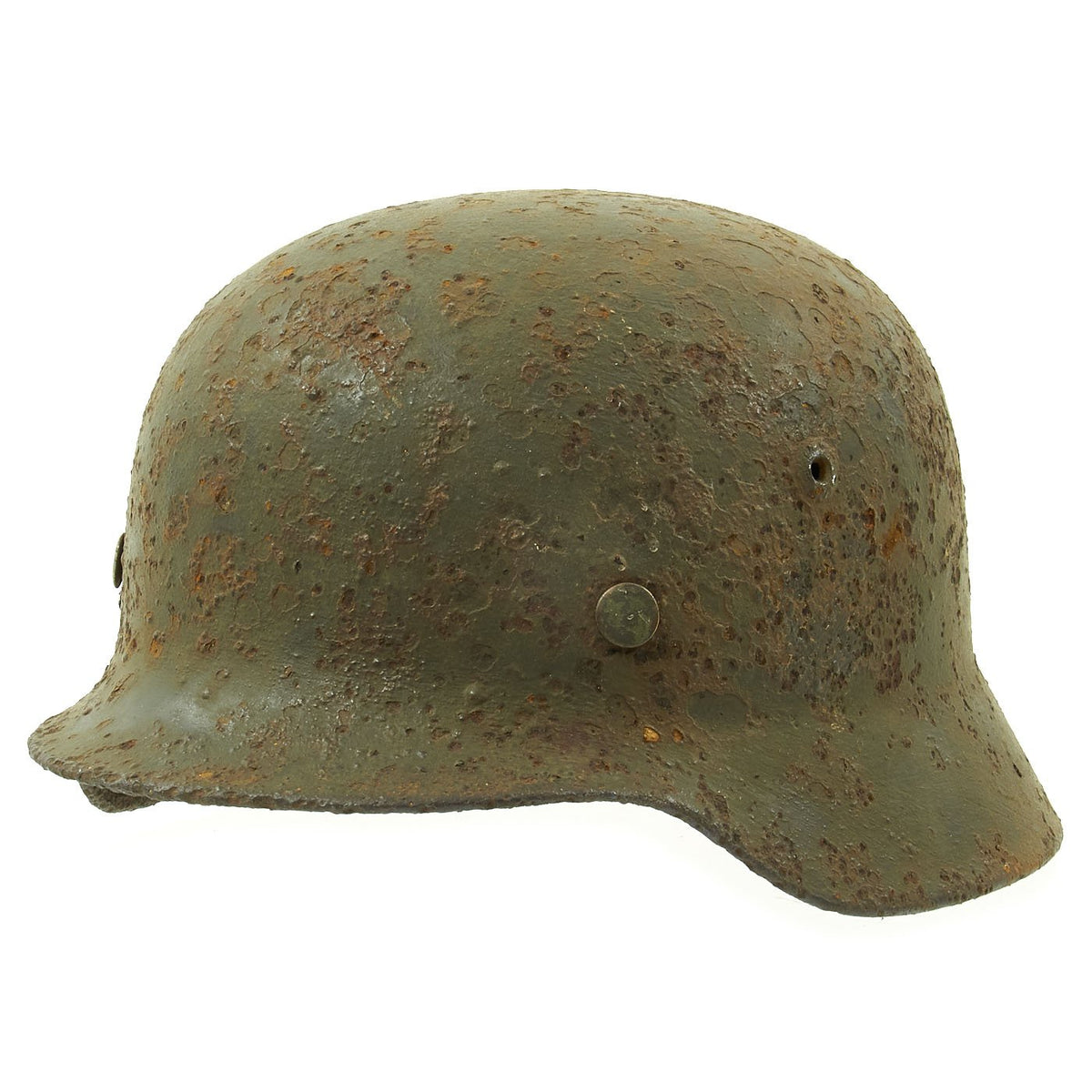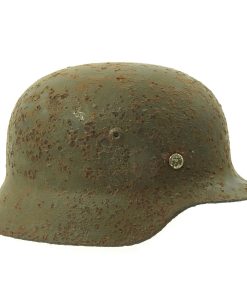Original German WWII M35 Eastern Front Demyansk Pocket Area Battlefield Pickup Helmet Original Items
$ 325,00 $ 97,50
Original Item: Only One Available. This is definitely a German helmet that has some stories to tell! It is offered in “battlefield pickup” condition, with significant rust damage, having been recovered from the Russian front area some years after the war. We were told that this example was specifically picked up from the Demyansk area in Russia, where the “Demyansk Pocket” encirclement occurred. The interior of the helmet still has the original leather liner, though it is somewhat degraded, and still attached to the original early war issue aluminum liner band, still held in place with original split pins. The chin strap is unfortunately completely gone.
From the looks of it, this helmet was most likely resting right side up, or else the liner would have been long gone. There is still a good amount of the original German Feldgrau paint on the shell, but there are also areas of significant pitting as well, as shown in the pictures. However, for battlefield pickup helmets, this only adds to the charm.
The interior of the helmet unfortunately has significant rust scaling where the maker and size markings would be. However, the side of the early aluminum liner band has a clearly legible 66 n.A 58 marking on the left side, indicating a size 58 liner for a size 66 shell. The other side has a maker marking, but it is mostly corroded, and only the date of 1939 can be read. Size 66 is a nice larger size that can accommodate liners from 58cm to 59cm or US 7 1/4 to 7 3/8. Size 66 shells are harder to find and are therefore more valuable to a collector.
Overall a very interesting genuine “Battlefield Pickup” M35 Russian Front helmet from the Demyansk Pocket area! This is an item that will only continue to appreciate in value over time.
The Demyansk Pocket (German: Festung Demjansk or Kessel von Demjansk; Russian: Демя́нский котёл) was the name given to the pocket of German troops encircled by the Red Army around Demyansk, south of Leningrad, during World War II on the Eastern Front. The pocket existed mainly from 8 February to 21 April 1942. A much smaller force was surrounded in the Kholm Pocket at the town of Kholm, about 100 km (62 mi) to the southwest. Both resulted from the German retreat following their defeat during the Battle of Moscow.
The successful defence of Demyansk, achieved through the use of an airbridge, was a significant development in modern warfare. Its success was a major contributor to the decision by the Army High Command to try the same tactic during the Battle of Stalingrad where it failed to save the 6th Army under Paulus.
More on the German M35 Helmet:
The first “modern” steel helmets were introduced by the French army in early 1915 and were shortly followed by the British army later that year. With plans on the drawing board, experimental helmets in the field, (“Gaede” helmet), and some captured French and British helmets the German army began tests for their own steel helmet at the Kummersdorf Proving Grounds in November, and in the field in December 1915. An acceptable pattern was developed and approved and production began at Eisen-und Hüttenwerke, AG Thale/Harz, (Iron and Foundry Works), in the spring of 1916.
These first modern M16 helmets evolved into the M18 helmets by the end of WWI. The M16 and M18 helmets remained in usage through-out the Weimar Reichswehr, (National Defence Force, Circa 1919-1933), era and on into the early years of the Third Reich until the development of the smaller, lighter M35 style helmet in June 1935.
In 1934 tests began on an improved Stahlhelm, whose design was a development of World War I models. The Eisenhüttenwerke company of Thale carried out prototype design and testing, with Dr. Friedrich Schwerd once again taking a hand.
The new helmet was pressed from sheets of molybdenum steel in several stages. The size of the flared visor and skirt was reduced, and the large projecting lugs for the obsolete armor shield were eliminated. The ventilator holes were retained, but were set in smaller hollow rivets mounted to the helmet’s shell. The edges of the shell were rolled over, creating a smooth edge along the helmet. Finally, a completely new leather suspension, or liner, was incorporated that greatly improved the helmet’s safety, adjustability, and comfort for each wearer. These improvements made the new M1935 helmet lighter, more compact, and more comfortable to wear than the previous designs.
The Army’s Supreme Command officially accepted the new helmet on June 25, 1935 and it was intended to replace all other helmets in service.
The M1935 design was slightly modified in 1940 to simplify its construction, the manufacturing process now incorporating more automated stamping methods. The principal change was to stamp the ventilator hole mounts directly onto the shell, rather than utilizing separate fittings. In other respects, the M1940 helmet was identical to the M1935. The Germans still referred to the M1940 as the M1935, while the M1940 designation were given by collectors.
Fast Shipping with Professional Packaging
Thanks to our longstanding association with UPS FedEx DHL, and other major international carriers, we are able to provide a range of shipping options. Our warehouse staff is expertly trained and will wrap your products according to our exact and precise specifications. Prior to shipping, your goods will be thoroughly examined and securely secured. We ship to thousands clients each day across multiple countries. This shows how we're dedicated to be the largest retailer on the internet. Warehouses and distribution centres can be located throughout Europe as well as the USA.
Note: Orders with more than one item will be assigned a processing date depending on the item.
Before shipping before shipping, we'll conduct a thorough inspection of the items you have ordered. Today, the majority of orders will be delivered within 48 hours. The delivery time will be between 3-7 days.
Returns
The stock is dynamic and we cannot completely manage it because multiple stakeholders are involved, including our factory and warehouse. So the actual stock may alter at any time. It's possible that you may not receive your order once the order has been made.
Our policy is valid for a period of 30 days. If you don't receive the product within 30 days, we are not able to issue a refund or an exchange.
You can only return an item if it is unused and in the same state as the day you received it. You must have the item in its original packaging.
Related products
Uncategorized
Uncategorized
Uncategorized
Uncategorized
Uncategorized
Uncategorized
Uncategorized
Armored Burgonet Helmet & Polearm from Scottish Castle Leith Hall Circa 1700 Original Items
Uncategorized
Uncategorized
Uncategorized
Uncategorized
Uncategorized
Uncategorized
Uncategorized
Uncategorized
Armoured Fighting Vehicles of the World: AFVs of World War One (Hardcover Book) New Made Items
Uncategorized
Angolan Rebel 1970s era 60mm Inert Display Mortar from Angolan Civil War Original Items
Uncategorized
Uncategorized
Uncategorized
Australian WWII Owen MK1 Machine Carbine SMG Custom Fabricated Replica with Sling Original Items

